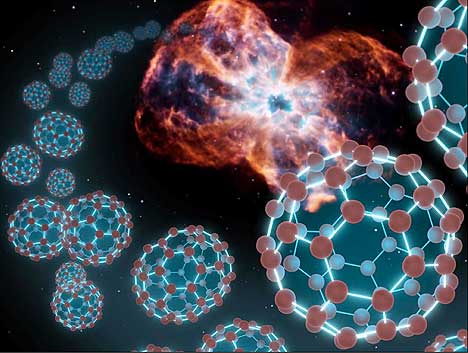
Space Balls — NASA's Spitzer Space Telescope has at last found buckyballs in space, as illustrated by this artist's conception showing the carbon balls coming out from the type of object where they were discovered — a dying star and the material it sheds, known as a planetary nebula. Buckyballs are made up of 60 carbon atoms organized into spherical structures that resemble soccer balls. They also look like Buckminister Fuller's architectural domes, hence their official name of buckministerfullerenes. The molecules were first concocted in a lab nearly 25 years ago, and were theorized at that time to be floating around carbon-rich stars in space. But it wasn't until now that Spitzer, using its sensitive infrared vision, was able to find convincing signs of buckyballs. The telescope found the molecules -- as well as their elongated, rugby-ball-like relatives, called C70 -- in the material around a dying star, or planetary nebula, called Tc 1. The star at the center of Tc 1 was once similar to our sun but as it aged, it sloughed off its outer layers, leaving only a dense white-dwarf star. Astronomers believe buckyballs were created in shed layers of carbon that blew off the star. Tc 1 does not show up that well in images, so a picture of the NGC 2440 nebula, taken by NASA's Hubble Space Telescope, was used in this artist's conception. Image credit: NASA/JPL-Caltech Hubble image credit: NASA, ESA, STScI
Astronomers using data from NASA's Spitzer Space Telescope have, for the first time, discovered buckyballs in a solid form in space. Prior to this discovery, the microscopic carbon spheres had been found only in gas form.
Formally named buckminsterfullerene, buckyballs are named after their resemblance to the late architect Buckminster Fuller's geodesic domes. They are made up of 60 carbon molecules arranged into a hollow sphere, like a soccer ball. Their unusual structure makes them ideal candidates for electrical and chemical applications on Earth, including superconducting materials, medicines, water purification and armor.
In the latest discovery, scientists using Spitzer detected tiny specks of matter, or particles, consisting of stacked buckyballs. They found them around a pair of stars called "XX Ophiuchi," 6,500 light-years from Earth.
"These buckyballs are stacked together to form a solid, like oranges in a crate," said Nye Evans of Keele University in England, lead author of a paper appearing in the Monthly Notices of the Royal Astronomical Society. "The particles we detected are miniscule, far smaller than the width of a hair, but each one would contain stacks of millions of buckyballs."
Buckyballs were detected definitively in space for the first time by Spitzer in 2010. Spitzer later identified the molecules in a host of different cosmic environments. It even found them in staggering quantities, the equivalent in mass to 15 Earth moons, in a nearby galaxy called the Small Magellanic Cloud.
In all of those cases, the molecules were in the form of gas. The recent discovery of buckyballs particles means that large quantities of these molecules must be present in some stellar environments in order to link up and form solid particles. The research team was able to identify the solid form of buckyballs in the Spitzer data because they emit light in a unique way that differs from the gaseous form.
"This exciting result suggests that buckyballs are even more widespread in space than the earlier Spitzer results showed," said Mike Werner, project scientist for Spitzer at NASA's Jet Propulsion Laboratory in Pasadena, California. "They may be an important form of carbon, an essential building block for life, throughout the cosmos."
Buckyballs have been found on Earth in various forms. They form as a gas from burning candles and exist as solids in certain types of rock, such as the mineral shungite found in Russia, and fulgurite, a glassy rock from Colorado that forms when lightning strikes the ground. In a test tube, the solids take on the form of dark, brown "goo."
"The window Spitzer provides into the infrared universe has revealed beautiful structure on a cosmic scale," said Bill Danchi, Spitzer program scientist at NASA Headquarters in Washington. "In yet another surprise discovery from the mission, we're lucky enough to see elegant structure at one of the smallest scales, teaching us about the internal architecture of existence."
NASA's Jet Propulsion Laboratory (JPL) in Pasadena, California, manages the Spitzer Space Telescope mission for NASA's Science Mission Directorate in Washington. Science operations are conducted at the Spitzer Science Center at the California Institute of Technology in Pasadena. Caltech manages JPL for NASA.
For information about previous Spitzer discoveries of buckyballs, visit.
For more information about Spitzer, visit.

